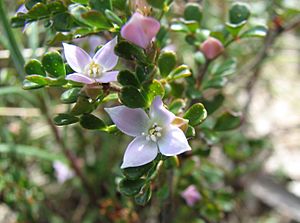Alpine boronia facts for kids
Quick facts for kids Alpine boronia |
|
|---|---|
 |
|
| Boronia algida Mount Buffalo National Park, Victoria |
|
| Scientific classification | |
 |
|
| Occurrence data from Australasian Virtual Herbarium |
Boronia algida, commonly known as alpine boronia, is a beautiful flowering plant that belongs to the citrus family, called Rutaceae. This plant is special because it is endemic to south-eastern Australia, meaning it only grows naturally in that area. It's an upright shrub with many branches, and its leaves are pinnate, which means they look a bit like a feather. The alpine boronia has lovely white to bright pink flowers, each with four petals. These flowers usually grow one by one at the ends of its branches.
Contents
What the Alpine Boronia Looks Like
The alpine boronia is a type of shrub that can grow to be about 0.3 to 1.5 meters (1 to 5 feet) tall. It has many branches, and some of them might be a bit hairy. The newest branches are often red.
Its leaves are pinnate, meaning they have smaller leaflets arranged along a central stem, like a feather. Each leaf is about 8 to 15 millimeters (0.3 to 0.6 inches) long and 4 to 5 millimeters (0.16 to 0.2 inches) wide. They usually have five to nine small leaflets. The stem that connects the leaf to the branch, called a petiole, is very short, about 0.5 to 1 millimeter long.
The flowers of the alpine boronia are white or bright pink. They usually grow alone, but sometimes you might see up to three flowers together at the end of a branch. Each flower has four sepals, which are like small, leaf-like parts that protect the flower bud. These sepals are triangular or egg-shaped and about 1 to 2.5 millimeters long. The four petals are larger, about 4 to 7 millimeters long.
Inside the flower, there are eight stamens, which are the parts that produce pollen. These stamens are different lengths. The ones closer to the sepals are longer than those closer to the petals. The alpine boronia flowers from September to February. After flowering, it produces smooth fruits called capsules, which are about 2.5 to 3 millimeters long.
How it Got its Name
The plant Boronia algida was first officially described in 1855 by a scientist named Ferdinand von Mueller. He thought it was a "charming bush." He wrote about it in his book, Definitions of rare or hitherto undescribed Australian plants.
The second part of its name, algida, is a Latin word that means "cold." Von Mueller chose this name because he noticed that this plant grows "on the highest stony slopes of our Alps," where it can be quite cold.
Where the Alpine Boronia Lives
The alpine boronia grows in areas with heathlands and forests. It prefers sandy soil that is found over granite rocks, usually in higher places. You can find this plant in south-eastern Australia, starting from the Gibraltar Range in New South Wales. It also grows in the Australian Capital Territory and in Victoria, specifically around Mount Buffalo, Mount Hotham, and the Nunniong Plateau.
See also
 In Spanish: Boronia algida para niños
In Spanish: Boronia algida para niños

